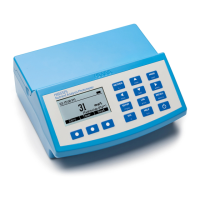51
METHOD PROCEDURES
51
51
IRON(II)/(III)
11.5. IRON(II)/(III)
SPECIFICATIONS
Range 0.00 to 6.00 mg/L (as Fe)
Resolution 0.01 mg/L
Accuracy ±0.10 mg/L ±2% of reading at 25 °C
Light Source LED with narrow band interference filter @ 525 nm
Method Adaptation of Standard Methods for the Examination of Water and
Wastewater, 23
rd
Edition, 3500-Fe B, Phenanthroline Method
REQUIRED REAGENTS
Code Description Quantity
HI96777A-0 Iron(II)/(III) Reagent A 1 packet
HI96777B-0 Iron(II)/(III) Reagent B 1 packet
REAGENTS SETS
HI96777-01 Reagents for 100 tests
HI96777-03 Reagents for 300 tests
For other accessories see ACCESSORIES section.
PRINCIPLE
During the first measurement, ferrous iron (Fe
2+
) reacts with 1,10-phenanthroline to form an orange-
red complex. During the second measurement, ferric iron (Fe
3+
) is converted to ferrous iron (Fe
2+
) by
the addition of Reagent B; the resulting measurement is the sum of ferrous (Fe
2+
) and ferric (Fe
3+
)
iron.
APPLICATION
Surface water, drinking water, mineral and groundwater, process control
SIGNIFICANCE & USE
Surface water typically contains up to 0.7 mg/L of iron. Drinking water typically contains up to 0.3 mg/L
of iron, but this level may increase significantly if plumbing fixtures contain iron. In well-oxygenated,
non-acidic waters, iron exists mainly in the ferric form (Fe
3+
) and will precipitate as iron oxide hydroxide
(FeO(OH)). However, anoxic water may have high levels of dissolved ferrous iron (Fe
2+
) which could
precipitate in heating/cooling systems or other equipment after exposure to air.
The Iron(II)/(III) method can be used to distinguish between the ferrous (Fe
2+
) and ferric (Fe
3+
)
forms of iron in a 2-step measurement process.

